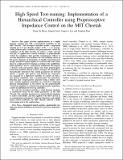High speed trot-running: Implementation of a hierarchical controller using proprioceptive impedance control on the MIT Cheetah
Author(s)
Hyun, Dong Jin; Seok, Sang Ok; Lee, Jongwoo; Kim, Sangbae
DownloadReduced converted Implementation of a Hierarchical Controller on the MIT Cheetah.pdf (11.29Mb)
OPEN_ACCESS_POLICY
Open Access Policy
Creative Commons Attribution-Noncommercial-Share Alike
Terms of use
Metadata
Show full item recordAbstract
This paper presents implementation of a highly dynamic running gait with a hierarchical controller on the MIT Cheetah. The developed controller enables high-speed running of up to 6 m/s (Froude number of Fr ≈ 7.34) incorporating proprioceptive feedback and programmable virtual leg compliance of the MIT Cheetah. To achieve a stable and fast trot gait, we applied three control strategies: (a) programmable virtual leg compliance that provides instantaneous reflexes to external disturbance and facilitates the self-stabilizing shown in the passive dynamics of locomotion; (b) tunable stance-trajectory design, intended to adjust impulse at each foot-end in the stance phase in a high speed trot-running according to the equilibrium-point hypothesis; and (c) a gait-pattern modulation that imposes a desired cyclic gait-pattern taking cues from proprioceptive TD feedback. Based on three strategies, the controller is hierarchically structured. The control parameters for forward speeds, a specific gait-pattern, and desired leg trajectories are managed by a high-level controller. It consists of both a gait-pattern modulator with proprioceptive leg TD detection and a leg-trajectory generator using a Bèzier curve and a tunable amplitude sinusoidal wave. Instead of employing physical spring/dampers in the robot’s leg, the programmable virtual leg compliance is realized using proprioceptive impedance control in individual low-level leg controllers.
To verify the developed controller, a robot dynamic simulator is constructed based on the model parameters of the MIT Cheetah. The controller parameters are tuned with the simulator to achieve self-stability, and then applied to the MIT Cheetah in an experimental environment. Using leg kinematics and applied motor current feedbacks, the MIT Cheetah achieved a stable trot-running gait in the sagittal plane.
Date issued
2014-08Department
Massachusetts Institute of Technology. Department of Mechanical EngineeringJournal
The International Journal of Robotics Research
Publisher
Sage Publications
Citation
Hyun, D. J., S. Seok, J. Lee, and S. Kim. “High Speed Trot-Running: Implementation of a Hierarchical Controller Using Proprioceptive Impedance Control on the MIT Cheetah.” The International Journal of Robotics Research 33, no. 11 (August 21, 2014): 1417–1445.
Version: Author's final manuscript
ISSN
0278-3649
1741-3176